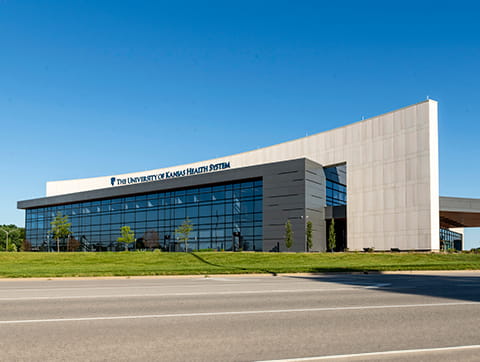MRI-Guided Focused Ultrasound
The University of Kansas Health System is our region’s first provider to offer an innovative, noninvasive treatment for essential tremor or Parkinson’s disease with hand tremor as the main symptom. It is an MRI-guided focused ultrasound called Exablate® Neuro.
Doctors use an MRI to direct the focused ultrasound precisely at the location in the brain causing the hand tremor. It destroys that tissue without risk or damage to the surrounding brain tissue. There is no need for surgical incisions.
What is MRI-guided focused ultrasound?
MRI-guided focused ultrasound is a noninvasive method of treatment that uses precisely directed ultrasound to create heat. This heat ablates, or burns, the specific area that causes the tremors. Doctors use magnetic resonance imaging to identify the precise location in the brain during the procedure, leaving surrounding tissue unaffected.
We offer a variety of appointment types. Learn more or call 913-588-1227 to schedule now.
Who can have MRI-guided focused ultrasound?
MRI-guided focused ultrasound may be a treatment option for people with essential tremor or with Parkinson’s disease when hand tremor is the primary symptom and medications have not worked. Patients with essential tremor must be at least 22 years old and patients with tremor-dominant Parkinson’s disease must be at least 30 years old to receive this treatment.
The FDA recently approved use of MRI-guided focused ultrasound for treatment of essential tremor on both sides of your body. To qualify, you must be 9 months out from having the first side of your brain treated and medication is not controlling your ET.
MRI-guided focused ultrasound is not suitable for all patients. You may not be eligible if you have:
- Metallic implants such as a pacemaker, neurostimulator, spine or bone fixation device, total joint replacement, metal clips, screws or cochlear implants
- Heart or spine issues that may make it difficult to tolerate the treatment or lie still for about 3 hours
- Extensive scarring on your scalp
- Tumors inside your skull
- Health conditions that require dialysis
- Active infection or severe uncontrolled disease
Talk with your doctor to determine your best treatment option.
How does MRI-guided focused ultrasound work?
Advanced technology allows this treatment technique to deliver focused ultrasound energy deep into the brain without requiring surgical incisions. Your neurosurgeon will use an MRI to precisely target the brain tissue that causes tremors. The ultrasound creates heat burning away the problem cells. By ablating the tissue, surgeons can safely reduce or stop tremors. Focused ultrasound has been shown to provide immediate tremor reduction with little or no hospitalization required.
MRI-guided focused ultrasound improving quality of life
Benefits and risks of MRI-guided focused ultrasound
This treatment offers several benefits:
- Patients experience nearly immediate results with a single treatment.
- MRI-guided focused ultrasound requires no surgical incisions, which reduces the risk of infection and shortens recovery time.
- It requires no implants and no radiation.
- The procedure requires only local anesthesia, so patients are relaxed and awake while the care team continuously monitors the patient’s comfort.
- The treatment usually takes only a few hours and most patients go home the same day.
There are some risks to the treatment. For short periods of time during the procedure, you may experience nausea, pain or other sensations. There is a risk of temporary or permanent numbness or tingling, unsteadiness, some abnormality in walking, or muscle weakness.
Innovative focused ultrasound
[Narrator] What is the Neuravive treatment? Neuravive is a new treatment for essential tremor where sound waves are focused through the skull to a target without the need for incisions, brain implants or radiation. It is based on high-intensity focused ultrasound guided by MR imaging. During the procedure ultrasound waves pass through the skull and are focused on a specific target in the brain. The temperature at the target rises high enough to create a tiny ablation or burn and provide a therapeutic effect, reducing the hand tremor. The MRI scanner provides images for the physician to clearly see the treatment area and provides images that show changes in temperature at the target.
What happens during MRI-guided focused ultrasound?
Before your procedure you will have an MRI, which your care team will use to pinpoint the area of your brain to be treated.
During the treatment, you will lie in an MRI scanner with your head fitted into a water-filled helmet. The helmet circulates cool water around your head to prevent overheating during the ultrasound. The energy is first applied at a low level and your doctor will ask you to provide feedback on the effect it has on your hand tremor.
You will be engaged throughout the process and may be asked to report the sensations you feel and to perform tasks such as writing or tracing lines to monitor improvement of your tremor. Your doctor will then adjust the focused ultrasound treatment in response to your input, increasing the energy level to perform the amount of ablation needed.
The focused ultrasound energy waves pass through the helmet to meet at the identified point in your brain. The energy makes a small lesion in the brain, targeting the tissue where the tremors originate.
Jessica Lovell:
How this procedure all begins, you start with a shave, makes sense because you’re going in to the brain area but how are we prepping the patient?
Jennifer Cheng, MD:
So, we first clip all the hair from the scalp because the hair would interfere with the ultrasound energy. So here we just have these clippers, they’re prepping the skin. So we have to place a frame on the patient’s head, which serves to help hold the head in place during surgery. So this is the neurosurgeons placing the frame. We anesthetize the skin and then the frame is held in place with four points. You’ll see that shortly, you see these little white screws are holding the frame to the patient’s head and then we place this hat, this you know, floppy looking hat thing on the head, and once all that is in place, the patient is then brought into the MRI scanning room and positioned on the MRI table. So that’s what you see here. You can see that the patient’s now lying down and their head is attached to the table and then there’s an ultrasound helmet, you couldn’t see it very well, but there was a helmet positioned around his head. So that, that like orange, you know, clear thing.
Jessica Lovell:
So animation because we can’t go inside that MRI room of course, but tell us exactly how this is being focused.
Jennifer Cheng, MD:
Right.
Jessica Lovell:
Pinpointed where you need it.
Jennifer Cheng, MD:
So this is an animation showing the ultrasound energy being focused on the target so there’s a target within the thalamus, which is deep within the brain, that is the target of treatments to treat tremor. So there’s 1,024 individually controlled ultrasound waves that are arrayed in that helmet and we can control them so they focus appropriately on a target. And when they focus there, they cause heating of the brain, raise the temperature in that brain tissue in that small, focused spot, and that creates the treatment.
Jessica Lovell:
So, you and your team are huddled, outside of the MRI room, what’s happening here?
Jennifer Cheng, MD:
Yeah, so here there are bunch of steps that we do including formulating our targets. So we use an MRI of the brain to formulate where the target should be, and then each time we are providing ultrasound energy into the brain, heating the brain, that’s done in short bursts lasting, you know, seconds long. We monitor using the MRI scanner at the same time so that we can see in real time what the brain temperature is. So you want to monitor to make sure that temperature stays in the correct range, you know, stays in the safe range, but also achieves a hot enough temperature to do the ablation.
Jessica Lovell:
Tell us about how long this is all taking.
Jennifer Cheng, MD:
So I mentioned brief sonication treatments, they typically start at about 10 seconds each and then can go up to 30 seconds, and then all together the whole procedure is 2 and a half to 3 hours.
Jessica Lovell:
So the results speak for themselves as we know.
Jennifer Cheng, MD:
Yeah.
Jessica Lovell:
We’ve seen them before, the handwriting tests. Tell us about what we’re seeing here.
Jennifer Cheng, MD:
So, these are typical tests used to test people’s tremor, and you can see people who have essential tremor have a difficult time drawing spirals, lines or even writing their name. So we do this test before, after and during the procedure. So this as an after video, where you can see that same patient you just saw struggling to write is now drawing straight lines.
Jessica Lovell:
See that name.
Jennifer Cheng, MD:
Yeah.
Jessica Lovell:
I bet that, what do you hear from the patients when they are able to see this in motion?
Jennifer Cheng, MD:
I have seen patients get very emotional often and when they are finally able to do something that they haven’t been able to do for years, people are amazed.
After treatment, you’ll be moved to a recovery room for monitoring. Most patients go home the same day. Many return to work and other activities within a couple of days. You will receive specific discharge instructions from your doctor.
Why choose us for MRI-guided focused ultrasound
The University of Kansas Health System is the only medical center in the region that provides MRI-guided focused ultrasound to treat essential tremor and Parkinson’s disease with hand tremor as the primary symptom. Our health system is 1 of only 47 medical centers around the world that the Parkinson’s Foundation has designated a Center of Excellence for Parkinson’s disease care.
When you choose The University of Kansas Health System for MRI-guided focused ultrasound, you will be cared for by a team of neurologists who are specialists in their fields. A dedicated nurse navigator will help you as you go through the processes needed leading up to your treatment. Our neurology and neurosurgery program is nationally ranked by U.S. News and World Report.






